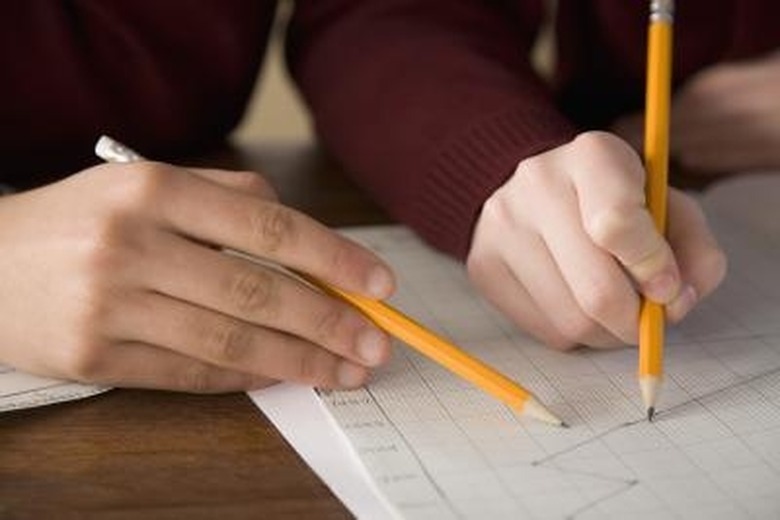How To Solve & Graph Linear Equations
A linear equation produces a straight line in a graph. The general formula for a linear equation is y = mx + b, where m stands for the slope of the line (which can be positive or negative) and b stands for the point that the line crosses the y-axis (the y intercept). Once you have graphed the equation, you can determine for any value at the x-axis the corresponding value of the y-axis or vice versa.
Step 1
Draw on graph paper a table of values by plugging in x values into your equation. You only need two points on the graph to be able to draw a line representing the linear equation. For example, if your line is y = 2x then your two points might be: y = 2(1) = 2, giving you (1,2) as a coordinate and y = 2(10) =20, giving you (10,20) as a coordinate.
Step 2
Draw an X-Y axis (sometimes called a Cartesian plane) on your graph paper. The X-Y axis looks like a large cross. The center of the cross (the "origin") should be in the center of your graph paper. Label this point "0."
Step 3
Label your X axis. Start 10 squares to the left of the origin and move to the right, labeling each square with a number from -10 to 10 (0 was already labeled in Step 2).
Step 4
Label your Y axis. Start 10 squares above the origin and move down, labeling each square with a number from -10 to 10 (0 was already labeled in Step 2).
Step 5
Graph your coordinate points. The coordinate point (1,10) represents (x,y) on the graph. In other words, find "1" on the x axis then trace upward with your finger to y = 10. Label this point (1,10). Use the same technique to label (10,20).
Step 6
Connect the two coordinate points with a straight line using your ruler. This is your linear graph. You can use it to solve the equation for any value of X: start at the correct X value on the number line (for example, x = 4) then trace upward to the linear graph. Stop where your finger hits the graph then read the Y value for that location.
Things Needed
- Graph paper
- Pencil
- Ruler
TL;DR (Too Long; Didn't Read)
A standard graph in math is a graph that goes from x = -10 to x = 10 and y = -10 to y = 10 on the number line, so that's why plugging in x=1 and x=10 to your equation is a good idea. If you have graph containing a wider range of coordinates (for example, up to 100 on the number line), you'll get a more accurate graph by making sure your points are spread apart (you might choose 1 and 100 in that case).
Cite This Article
MLA
Ellen, Stephanie. "How To Solve & Graph Linear Equations" sciencing.com, https://www.sciencing.com/solve-graph-linear-equations-6594775/. 24 April 2017.
APA
Ellen, Stephanie. (2017, April 24). How To Solve & Graph Linear Equations. sciencing.com. Retrieved from https://www.sciencing.com/solve-graph-linear-equations-6594775/
Chicago
Ellen, Stephanie. How To Solve & Graph Linear Equations last modified March 24, 2022. https://www.sciencing.com/solve-graph-linear-equations-6594775/
